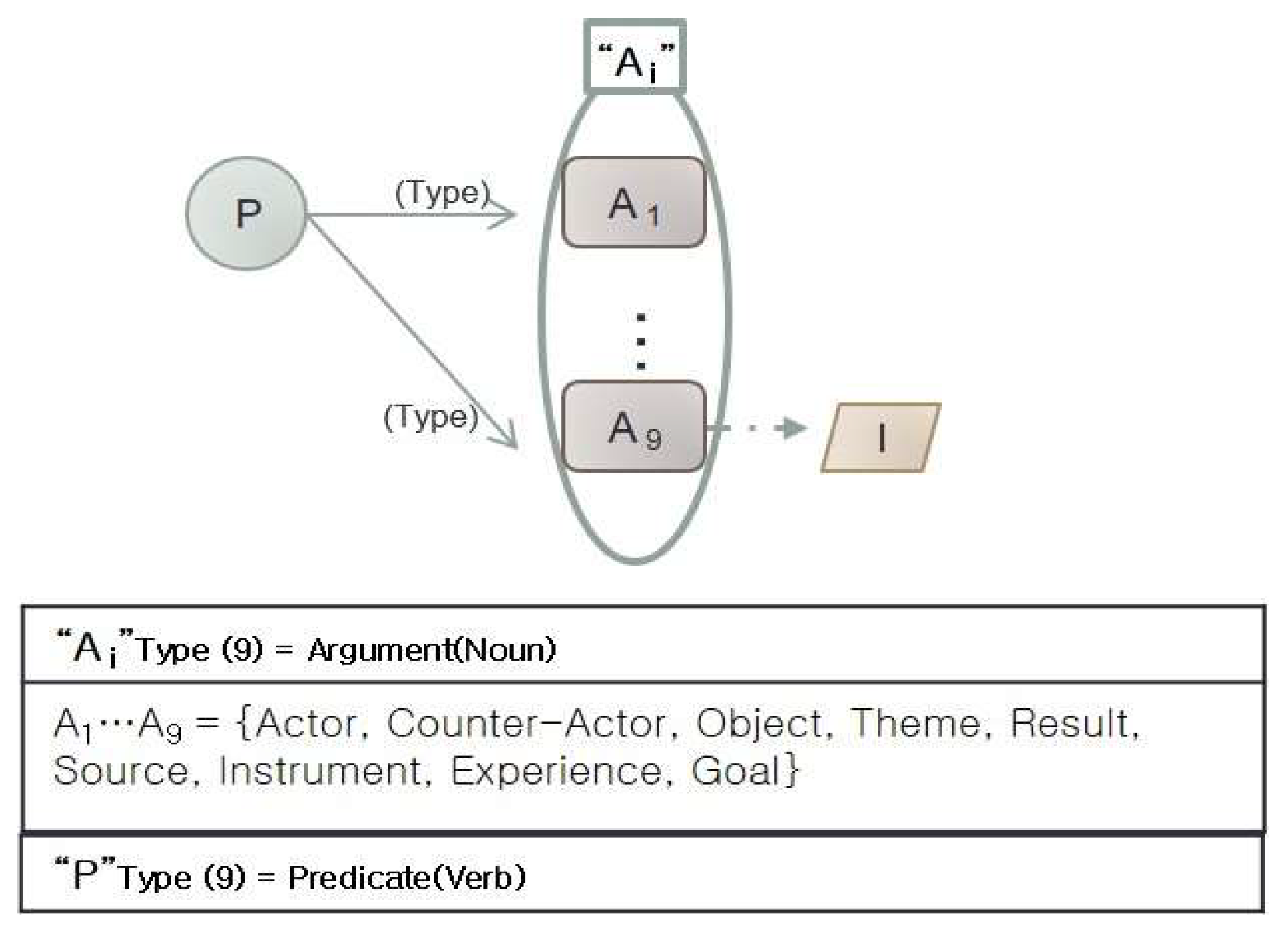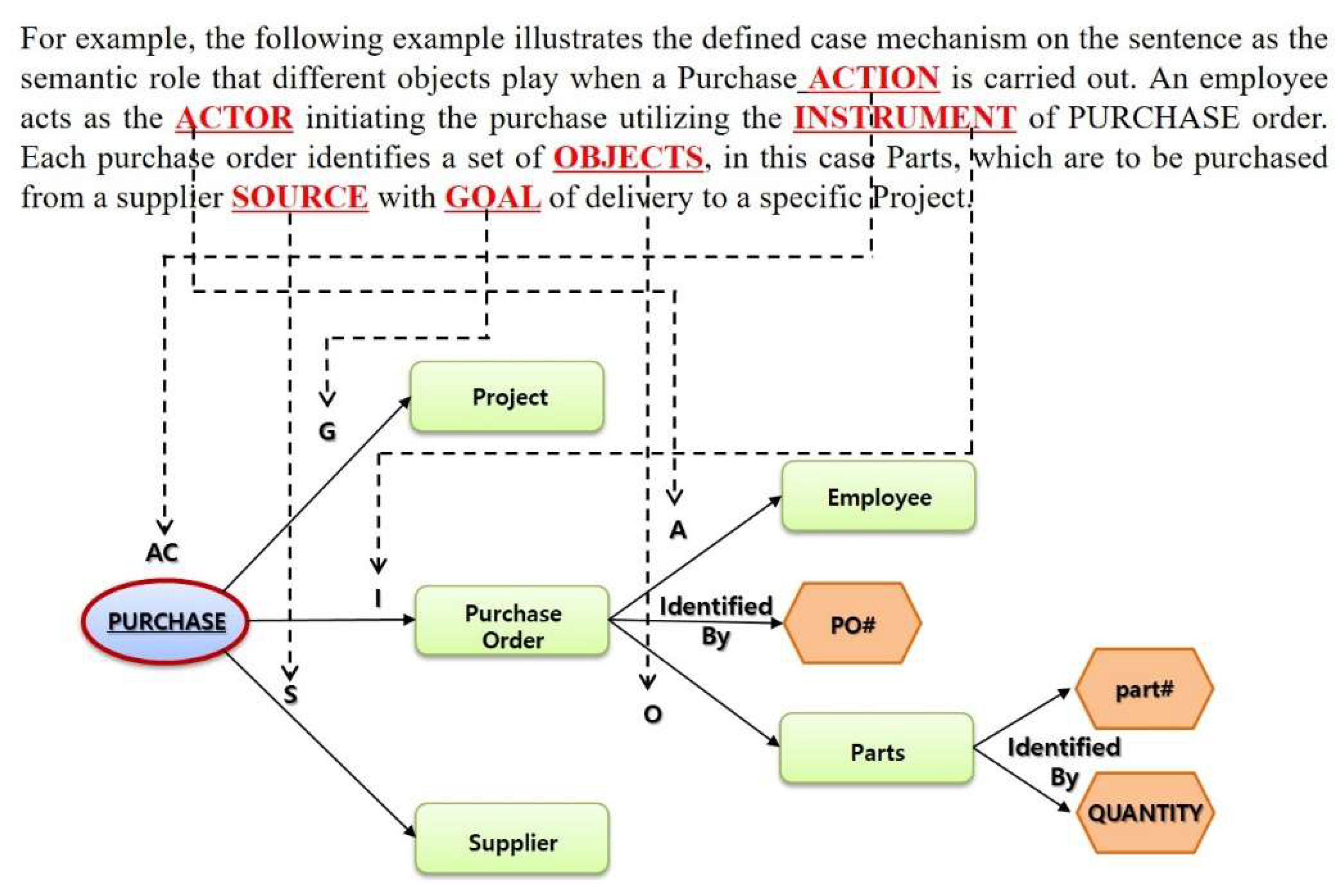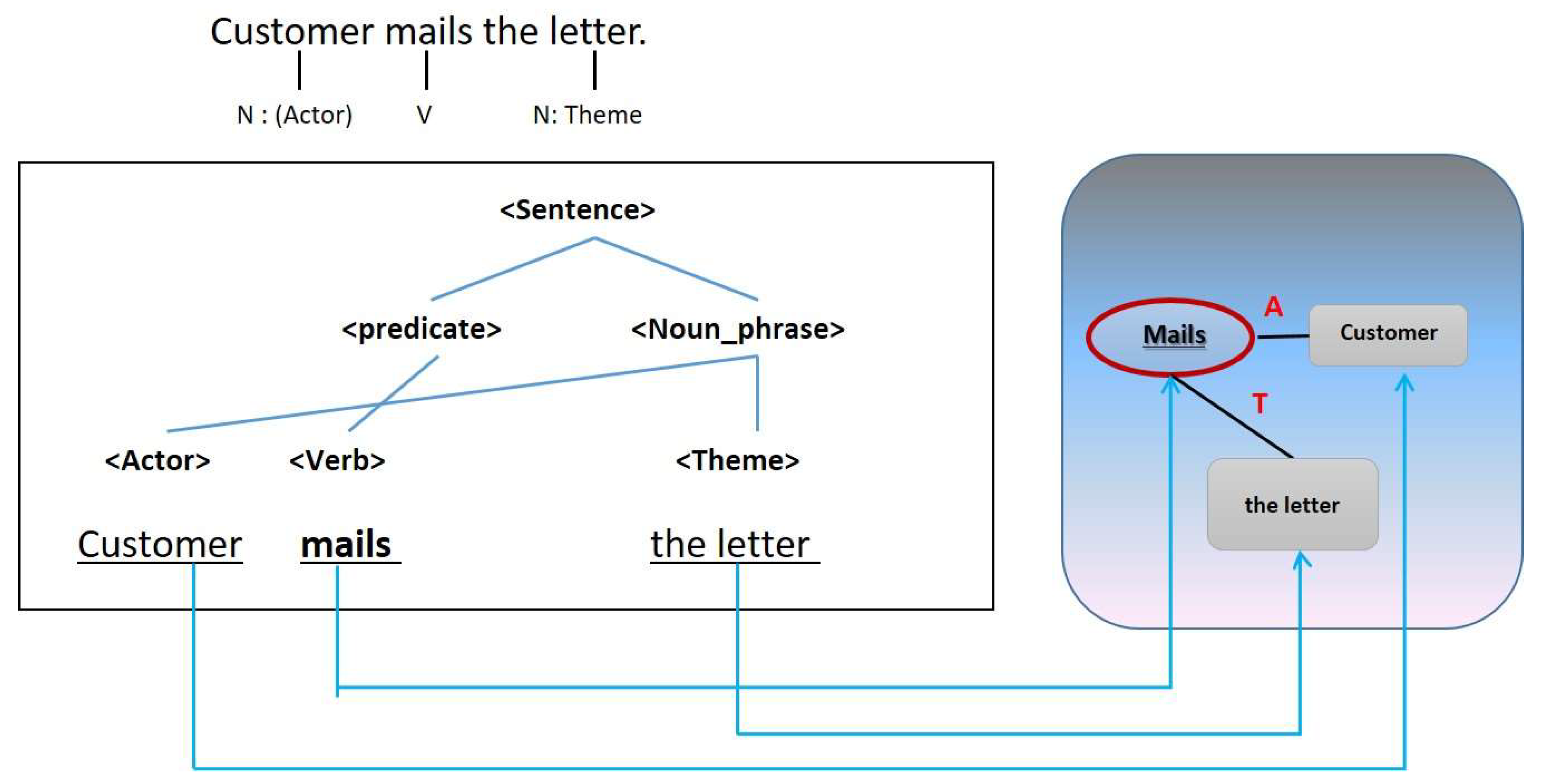Effort Estimation Approach through Extracting Use Cases via Informal Requirement Specifications
Abstract
:1. Introduction
2. Materials and Methods
2.1. Materials
2.1.1. The Original Fillmore’s Case Grammar
- (1)
- An Agent is a subject that is perceived to cause an action represented by a verb.
- (2)
- An Instrumental is an object that becomes the cause of an action or a state which a verb represents.
- (3)
- A Dative means a person or an animal affected by a state or an action represented by a verb.
- (4)
- An Objective is an object that is affected by an action or a state which a verb expresses.
- (5)
- A ‘Factitive’ means a person or an animal that exists as a result of an action and a condition of a verb.
- (6)
- A Locative refers to a state that a verb represents or where an action occurs.
2.1.2. The Existing Requirement Analysis Method
2.2. Methods for Adapting Requirement Engineering with Textual Approach
2.2.1. Our Refined Fillmore’s Case Mechanism
2.2.2. Visual Modeling as Transformation Modeling
2.2.3. Our Use Case Extraction Process with Informal Requirement Specification
- -
- This step analyzes natural language-oriented requirement specifications
- -
- This step analyzes a sentence structure of the requirement using a parser. Here, the parser extracts the textual relationships between sentences through analyzing their dependency characteristics.
- -
- This step lists verbs and nouns from the data analyzed in step 1 and 2. That is, we make a multiple list with VB*s and NP on terminal nodes from abstract symbol tree extracted by Stanford parser. The main verb will be distinguished from verbs with Abbot’s method [19].
- -
- This step identifies the relevant arguments according to the characteristics of the distinguished verbs and analyzes the arguments associated with each identified one. Then the transformed model based on improved grammar structure is used to identify the relationship between predicates (verbs) and arguments (nouns). If the relationship between the extracted verbs and nouns are performed repeatedly, a large chunk can be recognized as a unit of use-case like loosely connected in Graph theory. In other words, a use-case can be extracted & related semantically by having the relationships between verbs and arguments in some paragraph units of informal requirement specifications. In the extracted use-case, we extract the inclusion and extension relationships between use-cases. Inclusion identifies the functions that are commonly found in several use-cases. Extension is the ability to add or extend one use-case under certain conditions. Inclusion and Extension can be identified in analyzing sentences.
- -
- This step is software effort estimation, which calculates the total man-hours of the developing software using the use-case point (UCP) [22].
3. Results
4. Conclusions and Future Work
Author Contributions
Funding
Conflicts of Interest
References
- Lee, J.; Xue, N.L. Analyzing user requirements by use cases: A goal-driven approach. IEEE Softw. 1999, 16, 92–101. [Google Scholar]
- Bruegge, B.; Dutoit, A.H. Object-Oriented Software Engineering Using UML, Patterns, and Java. Learning 2009, 5, 7. [Google Scholar]
- Wiegers, K.E. Software Requirements; Microsoft Press: Washington, WA, USA, 2003. [Google Scholar]
- Ahn, S.B.; Kim, D.H.; Seo, C.Y.; Kim, R.Y.C. Object Extraction and Modeling Method from the User Requirements with Fillmore’s Case Grammar. J. KSEJW 2010, 16, 985–989. [Google Scholar]
- Anton, A.I. Goal-based Requirements Analysis. In Proceeding of the Second International Conference on Requirements Engineering (ICRE’96), Colorado Springs, CO, USA, 15–18 April 1996; pp. 136–144. [Google Scholar]
- Kim, J.T.; Park, S.Y.; Sugumaran, V. A Linguistics-Based Approach for Use Case Driven Analysis Using Goal and Scenario Authoring. Natural Language Processing and Information Systems. Lect. Notes Comput. Sci. 2004, 3136, 159–170. [Google Scholar]
- Seljan, S.; Kristina, V.; Zdravko, D. Sentende Representation in Context-Sensitive Grammars. Suvrem. Lingvist. 2002, 53, 205–218. [Google Scholar]
- Selian, S. Lexical-Functional Grammar of the Croatian Language: Theoretical and Practical Models. Ph.D. Thesis, University of Zagreb, Zagreb, Croatia, 2003. [Google Scholar]
- Seljan, S. The Role of the Lexicon in Lexical-Functional Grammar-Example on Croatian. In Proceedings of the 5th Slovenian and 1st International Language Technologies Conference IS-LTC 2006, Ljubljana, Slovenia, 9–10 October 2006; pp. 198–203. [Google Scholar]
- Ye, B.B. Case Grammar and its Application in English Vocabulary Teaching. In Proceedings of the 3rd International Conference on Applied Social Science Research (ICASSR 2015), Beijing, China, 22–23 May 2015. [Google Scholar]
- Cockburn, A. Writing Effective Use Cases; Addison-Wesley Professional: Boston, MA, USA, 2000. [Google Scholar]
- Cockburn, A. Using goal-based use cases. J. Object Oriented Program. 1997, 10, 56. [Google Scholar]
- Park, B.K.; Son, H.S.; Kim, J.S.; Kim, R.Y.C. Refined Visual Modeling for Extracting Use Case Mechanism on Customer Requirements. In Proceedings of the International Conference on Convergence Technology ICCT2016, Jeju, Korea, 29 June 2016; Volume 6, pp. 640–641. [Google Scholar]
- Park, B.K.; Kwon, H.E.; Kang, G.H.; Yang, H.S.; Hwang, J.S.; Kim, R.Y.C. Use Case Extraction and Prioritization Approach from Requirements. KCSE 2014, 17, 394–395. [Google Scholar]
- Fillmore, C.J. The Case for Case. Universals in Linguistic Theory, ed. by Emmon Bach and Robert T. Harms, 1-90; Holt, Rinehart & Winston: New York, NY, USA, 1968. [Google Scholar]
- Vinay, S.; Aithal, S.; Desai, P. An Approach towards Automation of Requirements Analysis. In Proceedings of the International MultiConference of Engineers and Computer Scientists, Hong Kong, China, 14–16 March 2009; Volume 1. [Google Scholar]
- Kim, J.T.; Kim, D.S.; Park, S.Y. An Integrated Requirements Analysis Method based on Goal and Scenario. J. KISS Softw. Appl. 2004, 31, 543–554. [Google Scholar]
- Sibarani, E.M.; Hutagaol, A.; Simarmata, D.; Manihuruk, J. Actor and Use Case Extraction from Text-Based Requirement Specification. In Proceedings of the International Conference Image Processing. Computers and Industrial Engineering (ICICIE’2014), Kuala Lumpur, Malaysia, 15–16 January 2014. [Google Scholar]
- Abbott, R.J. Program Design by Informal English Descriptions. Commun. ACM 1983, 26, 882–894. [Google Scholar]
- Kim, B.Y. Use Case Extraction Method of Customer Requirements Based on Refined Fillmore Case Grammar Mechanism. Master’s Thesis, University of Hongik, Seoul, Korea, 2013. [Google Scholar]
- Park, B.; Yang, H.; Kim, R.Y. A Method to Identify Goal Use-Case(s) with Refined Fillmore’s Case Grammar. In Proceedings of the Korea Information Processing Society Conference, Korea Information Processing Society, Jeju, Korea, 8–9 November 2013; pp. 1011–1014. [Google Scholar]
- Karner, G. Resource estimation for objectory projects. Object. Syst. SF AB 1993, 17, 1–9. [Google Scholar]
- Stanford Parser. Available online: https://nlp.stanford.edu/software/lex-parser.shtml (accessed on 20 January 2020).














| Case | Definition |
|---|---|
| Agent | A person or entity causing a verb’s action to be performed. |
| Counter agent | The force or resistance against which a verb’s action is carried. |
| Object | An entity affected directly by a transitive verb’s action. |
| Experiencer | A person or thing affected by a verb’s action, replacing of the dative. |
| Source | The place from which something moves. |
| Goal | The place to which something moves. |
| Locative | Location or spatial orientation of the state or action. |
| Instrument | The inanimate entity causally involved in a verb’s action. |
| Time | The time of the event. |
| Case | Notation | Definition |
| Actor | A | The instigator of the event/action. |
| Counter actor | CA | The force or resistance against which an action is carried out. |
| Object | O | The entity which moves or changes or whose existence is in consideration. |
| Theme | TO | The subjective entity of Objects |
| Result | R | “Entity” that comes into existence as a result of the action. |
| Source | S | Origin of object. |
| Instrument | I | Facility used in carrying out an event. |
| Experience | E | “Entity” that receives or accepts or experiences or undergoes the effect of an action. |
| Goal | G | Destination of object. |
| Main Verb | V | A change defined by an event. |
| Case | Notation | Comment |
|---|---|---|
| Predicate |  | Represent main verb in a sentence. |
| Argument |  | Represent nouns that is related to subjective verb in a sentence. |
| Identification of the same ‘Ai’ Type |  | Identification Line. |
| Noun (not include case mechanism) |  | Nouns that is not related to case mechanism. |
| Part of Speech | Model Component | Definition |
|---|---|---|
| Proper Noun | Object | Jim, Smith |
| Doing Verb | Method | Buy, Recommend |
| Being Verb | Inheritance | Is-a (kind-of) |
| Having Verb | Aggregation | Has an |
| Transitive Verb | Method | Enter |
| Intransitive Verb | Method (Event) | Depends on |
| Use Case Name | Actor | Use Case | UUCP | TCF | EF |
|---|---|---|---|---|---|
| Mail the letter | 3 | 15 | 18 | 30 | 11 |
| Bank the financial service | 3 | 15 | 18 | 32 | 11.5 |
| Cancel Transaction | 2 | 10 | 12 | 28.5 | 9.5 |
| Register Information | 1 | 5 | 6 | 16.5 | 9 |
| Total | 9 | 45 | 54 | 107 | 41 |
| Final Technical Complexity Factor | 1.67 | ||||
| Final Environmental Factor | 0.17 | ||||
| use-case point | 15.3306 | ||||
| Total Man-Hours (ER:20) | 306.612 | ||||
© 2020 by the authors. Licensee MDPI, Basel, Switzerland. This article is an open access article distributed under the terms and conditions of the Creative Commons Attribution (CC BY) license (http://creativecommons.org/licenses/by/4.0/).
Share and Cite
Park, B.K.; Kim, R.Y.C. Effort Estimation Approach through Extracting Use Cases via Informal Requirement Specifications. Appl. Sci. 2020, 10, 3044. https://doi.org/10.3390/app10093044
Park BK, Kim RYC. Effort Estimation Approach through Extracting Use Cases via Informal Requirement Specifications. Applied Sciences. 2020; 10(9):3044. https://doi.org/10.3390/app10093044
Chicago/Turabian StylePark, Bo Kyung, and R. Young Chul Kim. 2020. "Effort Estimation Approach through Extracting Use Cases via Informal Requirement Specifications" Applied Sciences 10, no. 9: 3044. https://doi.org/10.3390/app10093044
APA StylePark, B. K., & Kim, R. Y. C. (2020). Effort Estimation Approach through Extracting Use Cases via Informal Requirement Specifications. Applied Sciences, 10(9), 3044. https://doi.org/10.3390/app10093044




